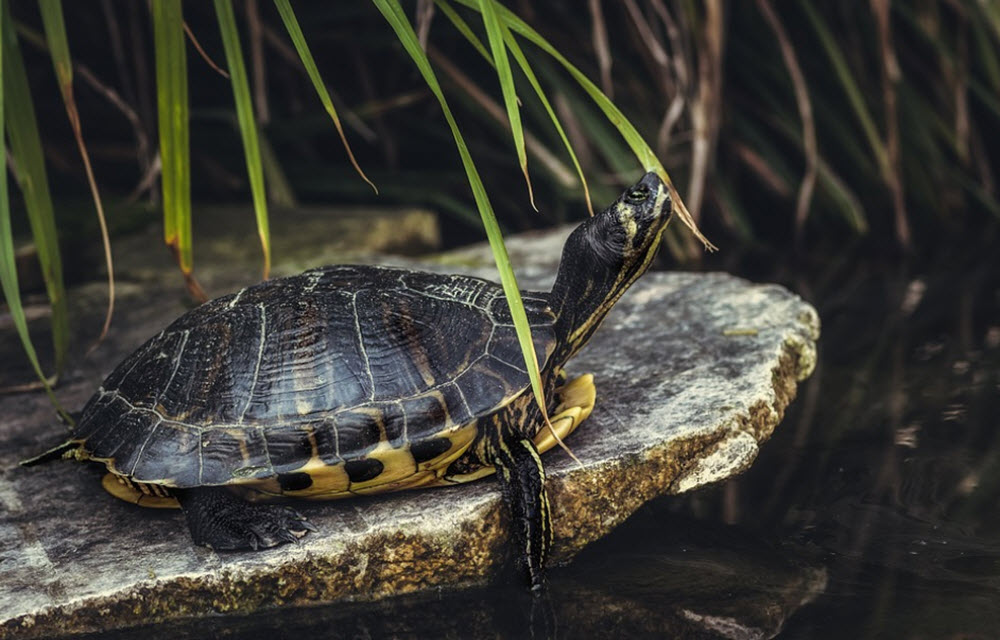Contents
Pond turtles, with their distinctive shells and gentle disposition, are a delightful presence in aquatic ecosystems. These reptiles, belonging to various species, have adapted to thrive in freshwater environments. This article explores the captivating world of pond turtles, shedding light on different species and their requirements for a flourishing life.

Understanding Pond Turtles
Defining Characteristics
Pond turtles, also known as freshwater turtles, primarily inhabit slow-moving or stagnant water bodies such as ponds, lakes, and marshes. They are distinguished by their webbed feet, which aid in swimming, and a carapace (shell) that protects them from predators.
Ecological Importance
Pond turtles play a vital role in maintaining the ecological balance of freshwater habitats. They contribute to nutrient cycling, aid in seed dispersal, and help control insect populations.
Common Species of Pond Turtles
Red-eared Slider (Trachemys scripta elegans)
One of the most popular pond turtles, the Red-eared Slider is known for the small red stripe behind each ear. They are native to the southern United States but have been introduced worldwide.
Painted Turtle (Chrysemys picta)
Characterized by vibrant markings on their carapace, Painted Turtles are widespread in North America. They are adept swimmers and spend considerable time basking in the sun.
Spotted Turtle (Clemmys guttata)
With yellow spots adorning its dark carapace, the Spotted Turtle is easily recognizable. They are relatively small and inhabit shallow waters with abundant vegetation.
Diamondback Terrapin (Malaclemys terrapin)
Though mainly associated with brackish waters, the Diamondback Terrapin can sometimes be found in freshwater ponds. They are distinguished by the diamond-shaped patterns on their carapace.
European Pond Turtle (Emys orbicularis)
Native to Europe and parts of Asia, the European Pond Turtle is a robust species with a dark, oval carapace. They inhabit a variety of freshwater ecosystems and are adept swimmers.
Caring for Pond Turtles
Suitable Habitat
A proper habitat is crucial for the well-being of pond turtles. They require access to water deep enough for swimming, along with basking spots and hiding places. Aquatic plants can also enhance the habitat’s quality.
Diet and Nutrition
Pond turtles are usually omnivorous, consuming a variety of aquatic plants, insects, and small fish. It’s important to provide a balanced diet to meet their nutritional needs.
Regular Health Check
Monitoring the health of pond turtles is essential. Regular checks for signs of illness or distress, and prompt attention to any health issues, can ensure their well-being.
Conservation Efforts
Habitat Preservation
Many pond turtle species are facing habitat loss due to pollution and human activities. Preserving and restoring aquatic habitats is vital for the conservation of pond turtles.
Legal Protections
Some species of pond turtles are protected under law due to their vulnerability. It’s essential to be aware of and respect legal protections in place for these gentle reptiles.
Community Involvement
Engaging communities in conservation efforts, educating them about the importance of pond turtles, and involving them in habitat restoration projects can be highly effective.
Pond turtles are an enchanting and ecologically significant group of reptiles. Understanding their diverse species, providing them with proper care, and engaging in conservation efforts are crucial for ensuring their continued survival and well-being in the freshwater ecosystems they inhabit. Their grace and resilience serve as a reminder of the beauty and diversity of life in our planet’s waters.
